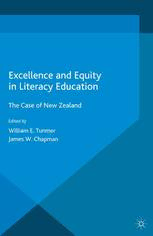
Excellence and Equity in Literacy Education: The Case of New Zealand PDF
Preview Excellence and Equity in Literacy Education: The Case of New Zealand
Excellence and Equity in Literacy Education PalgraveStudiesinExcellenceandEquityinGlobalEducation SeriesEditors: RogerOpenshaw,InstituteofEducation,MasseyUniversity,NewZealand MargaretWalshaw,InstituteofEducation,MasseyUniversity,NewZealand Thisseriesaimstocompilearichcollectionofresearch-basedcontributionsthat critically examine the tensions and challenges involved in implementing both excellence and equity within public education systems around the globe. In bringing together eminent international scholars to explore the various ways education systems around the world have responded to issues associated with excellenceandequity,thisserieswillmakeamajorcontributiontothefieldand actasastate-of-the-artresourceonwhatweknowaboutthistopictoday. Titlesinclude: BrianBarrettandElizabethRata(editors) KNOWLEDGEANDTHEFUTUREOFTHECURRICULUM InternationalStudiesinSocialRealism WilliamE.TunmerandJamesW.Chapman(editors) EXCELLENCEANDEQUITYINLITERACYEDUCATION TheCaseofNewZealand PalgraveStudiesinExcellenceandEquityinGlobalEducation SeriesStandingOrderISBN978–1–137–40048–2Hardback ISBN978–1–137–40049–9Paperback (outsideNorthAmericaonly) You can receive future titles in this series as they are published by placing a standing order. Please contact your bookseller or, in case of difficulty, write to usattheaddressbelowwithyournameandaddress,thetitleoftheseriesand theISBNquotedabove. Customer Services Department, Macmillan Distribution Ltd, Houndmills, Basingstoke,HampshireRG216XS,England Excellence and Equity in Literacy Education The Case of New Zealand Editedby William E. Tunmer DistinguishedProfessorofEducationalPsychology,InstituteofEducation,Massey University,NewZealand James W. Chapman ProfessorofEducationalPsychology,InstituteofEducation,MasseyUniversity,New Zealand Selection,introductionandeditorialmatter©WilliamE.Tunmerand JamesW.Chapman2015 Individualchapters©Respectiveauthors2015 Foreword©GailT.Gillon2015 Softcover reprint of the hardcover 1st edition 2015 978-1-137-41556-1 Allrightsreserved.Noreproduction,copyortransmissionofthis publicationmaybemadewithoutwrittenpermission. Noportionofthispublicationmaybereproduced,copiedortransmitted savewithwrittenpermissionorinaccordancewiththeprovisionsofthe Copyright,DesignsandPatentsAct1988,orunderthetermsofanylicence permittinglimitedcopyingissuedbytheCopyrightLicensingAgency, SaffronHouse,6–10KirbyStreet,LondonEC1N8TS. Anypersonwhodoesanyunauthorizedactinrelationtothispublication maybeliabletocriminalprosecutionandcivilclaimsfordamages. Theauthorshaveassertedtheirrightstobeidentifiedastheauthorsofthiswork inaccordancewiththeCopyright,DesignsandPatentsAct1988. Firstpublished2015by PALGRAVEMACMILLAN PalgraveMacmillanintheUKisanimprintofMacmillanPublishersLimited, registeredinEngland,companynumber785998,ofHoundmills,Basingstoke, HampshireRG216XS. PalgraveMacmillanintheUSisadivisionofStMartin’sPressLLC, 175FifthAvenue,NewYork,NY10010. PalgraveMacmillanistheglobalacademicimprintoftheabovecompanies andhascompaniesandrepresentativesthroughouttheworld. Palgrave®andMacmillan®areregisteredtrademarksintheUnitedStates, theUnitedKingdom,Europeandothercountries. ISBN 978-1-349-68210-2 ISBN 978-1-137-41557-8 (eBook) DOI 10.1007/978-1-137-41557-8 Thisbookisprintedonpapersuitableforrecyclingandmadefromfully managedandsustainedforestsources.Logging,pulpingandmanufacturing processesareexpectedtoconformtotheenvironmentalregulationsofthe countryoforigin. AcataloguerecordforthisbookisavailablefromtheBritishLibrary. LibraryofCongressCataloging-in-PublicationData Excellenceandequityinliteracyeducation:thecaseofNewZealand/editedby WilliamE.Tunmer,JamesW.Chapman. pages cm—(Palgravestudiesinexcellenceandequityinglobaleducation) Summary:“Literacyisarguablythemostimportantgoalofschoolingas,toalarge extent,itdeterminesyoungchildren’seducationalandlifechancesandis fundamentalinachievingsocialjustice.NewZealand’sliteracyeducationprogramme haslongbeenregardedasoneoftheworld’smostsuccessfulapproachestoteaching literacyskillstoyoungchildren.ExcellenceandEquityinLiteracyEducation questionsthiswidelyheldassumption.Inthelate1990stheNewZealand governmentdevelopedanationalliteracystrategyaimedatreducingpersistently largeinequitiesinliteracyachievementoutcomes.Thechaptersinthisedited volumepresentevidenceindicatingthatthenationalliteracystrategyhasfailed, examinethemajorfactorsresponsibleforthecontinuationofNewZealand’s comparativelywidespreadofscoresinliteracyachievement,anddescribethemost effectivestrategiesforreducingtheliteracyachievementgapandachieving excellenceandequityinNewZealandliteracyeducation”—Providedbypublisher. 1. Languagearts—NewZealand. 2. Literacy—NewZealand. 3. Educational equalization—NewZealand. I. Tunmer,W.E.(WilliamE.),1947–editor ofcompilation. II. Chapman,JamesW.(JamesWilliam),1948–editorof compilation. LB1576.E9352015 372.6—dc23 2015003637 Contents ListofTablesandFigures vii Foreword viii SeriesPreface xi NotesonContributors xiv 1 TheDevelopmentofNewZealand’sNationalLiteracy Strategy 1 WilliamE.TunmerandJamesW.Chapman Part I EvidencethatNewZealand’sNational LiteracyStrategyHasFailed 2 FindingsfromNewZealand’sParticipationintheProgress inInternationalReadingLiteracyStudyin2001,2006, and2011 23 JaneE.Prochnow,WilliamE.Tunmer,andKeithT.Greaney 3 IsReadingRecoveryanEffectiveEarlyLiteracy InterventionProgrammeforChildrenWhoMostNeed LiteracySupports? 41 JamesW.Chapman,KeithT.Greaney,andWilliamE.Tunmer 4 LiteracyPerformancesofYoungAdultsinNewZealand: OutcomesofSchool-BasedLiteracyInstruction 71 JamesW.Chapman,KeithT.Greaney,andJaneE.Prochnow Part II FactorsContributingtotheFailureof NewZealand’sNationalLiteracyStrategy 5 LiteracyandtheEarlyEducationCurriculumin NewZealand 95 ClaireJ.McLachlanandAlisonW.Arrow 6 PedagogicalConstructivisminNewZealandLiteracy Education:AFlawedApproachtoTeachingReading 121 WilliamE.Tunmer,KeithT.Greaney,andJaneE.Prochnow v vi Contents 7 LiterateCulturalCapitalandMatthewEffectsinReading Achievement 145 JaneE.Prochnow,WilliamE.Tunmer,andAlisonW.Arrow Part III StrategiesforReducingtheLiteracy AchievementGapandAchievingExcellenceand EquityinNewZealandLiteracyEducation 8 MeetingtheNeedsofBeginningReadersthrough DifferentiatedInstruction 171 AlisonW.Arrow,JamesW.Chapman,andKeithT.Greaney 9 TeacherKnowledgeNeededforDifferentiatedEarly ReadingInstruction 194 AlisonW.Arrow,ClaireJ.McLachlan,andKeithT.Greaney 10 ElevenMythsaboutLiteracyEducationinNewZealand 214 JamesW.Chapman,JaneE.Prochnow,andAlisonW.Arrow Index 236 Tables and Figures Tables 2.1 Means,standarddeviations,andpercentilesofthe readingachievementscoresforNewZealandasa functionofPIRLStestcycle 26 2.2 MeansandstandarddeviationsofthePIRLS2011 readingachievementscoresforEnglish-speaking comparisoncountries 27 2.3 ThemeanreadingachievementscoresforNewZealand asafunctionofethnicityandPIRLStestcycle 28 Figures 4.1 Literacylevelscorepercentagesasafunctionofage 80 4.2 Literacylevelscorepercentagesasafunctionofethnic background 83 4.3 LiteracylevelscorepercentagesasafunctionofRDand NRDgrouping 84 8.1 Cognitivefoundationsoflearningtoreadframework (Tunmer&Hoover,2014) 177 vii Foreword At a global level, leaders are focused on raising literacy achievement for children most in need. Despite significant investment in some of theworld’swealthiestcountries,childrenfromindigenousandminority populations,childrenraisedinpovertyorlowsocio-economiccommu- nities, and children with disability continue to fall well behind their expectedlevelsofachievementforreadingandwritingthroughouttheir schoolyears.NewZealandisnoexception. Latestfindingsfromlarge-scalestudies,suchastheProgressinInter- nationalReadingLiteracyStudy(PIRLS),indicatethatNewZealandhas oneofthelargestdifferencesbetweenitshigh-andlow-performingread- ersintheworld.Theauthorsofthisvolumehaveundertakenacritically important investigation into New Zealand’s national literacy strategy that has aimed to reduce the inequities evident in literacy achieve- ment.Throughexaminingavailabledata-basedevidencefrommultiple sources,theauthorsquestionthesuccessofNewZealand’scurrentliter- acypolicies,practices,anditsnationalreadinginterventionprogramme andbravelychallengethecountry’shistoricalreputationforexcellence inreadinginstruction. The authors critique New Zealand’s national literacy strategy to gain insightsintocontributingfactorstovariabilityinreadingachievement. Such insights are of international importance. New Zealand is a good choice as a case study: a small country of 4.6 million people, it has an educational and social context that provides many positive facil- itators for literacy success. For example, literacy in its many forms is highly valued in New Zealand; parents are frequently engaged in their children’slearning;educationalleadersstronglyadvocatefortheimpor- tance of achieving literacy success for every child; there is significant investmentinteachers’professionallearning;schoolsarerelativelywell resourced; and there are rigorous national quality assurance processes for the preparation of teachers and registration of teachers. Further, NewZealandisdevelopingagrowinginternationalreputationforfocus- ing on education success of Ma¯ori (its indigenous people). The work of leading New Zealand researchers in understanding the importance of developing children’s cultural identity, culturally responsive teach- ing practices, and bicultural approaches to educational curriculum are all at the forefront of international indigenous debates. These positive viii Foreword ix factorscontributetoNewZealand’stopreadersbeingamongthebestin theworld.Indeed,theauthors’analysisrevealsthatNewZealandhasa relativelylargeproportionofchildrenachievingatthehighestlevelsof readingcomprehensioncomparedtoothercountries. Yetwiththesemanypositivefactorstopromoteliteracysuccess,why doresultsfromliteracyassessmentsofchildreninNewZealandconsis- tently demonstrate a “long tail” of underachievers, and why has there beensuchlittleimprovementinclosingthegapbetweenhigh-andlow- performingreadersovertime?Theauthorsofthisvolumeuseevidence from both child and adult literacy data sets to address these questions and critically examine reading policies, practices, and interventions. Their analysis and scholarly interpretation of available data seriously challengetheeffectivenessofreadinginstructionalapproachesandthe national reading intervention programme, Reading Recovery (RR). In undertaking the first independent investigation of the New Zealand national monitoring data related to RR, the authors highlight the con- sistent pattern of underachievement in reading for Ma¯ori and Pacific children and children from low socio-economic communities over the last10years.Theycriticizeclassroomandinterventionpracticesforfail- ing to significantly alter this pattern towards more successful literacy outcomes. Theauthorschallengetheconstructivistapproachtoliteracyinstruc- tion based on a multiple cues theoretical model which has historically dominated early reading instruction in New Zealand. Advocating for an alternative approach, the authors draw the reader’s attention to the overwhelming scientific evidence demonstrating the importance of phoneme awareness (awareness that words are made up of indi- vidual sounds or phonemes) and letter knowledge to early reading success.Theysummarizelarge-scalemeta-analysesandliteraturereviews tosupporttheiradvocacyforensuringthatexplicitinstructioninword analysis skills is systematically included in literacy instruction to help close the gap between high- and low-performing readers. They high- light the importance of differentiated reading instruction for children fromschoolentrybasedonappropriateindividualassessmentdata. Although the authors may place some readers in an uncomfortable positionattimesthroughtheircriticalanalysisofinstructionalreading methodsandcurriculumdesign(thatmanypractitionersandeducation- alistspassionatelydefend),thestakesaretoohightobeclosed-minded tothefactsanddiscussionpresented.Astheauthorsemphasize,theben- efitsthataccruefromliteracysuccessforindividuals,theirfamilies,and their communities mandate that we must continue to strive for more
